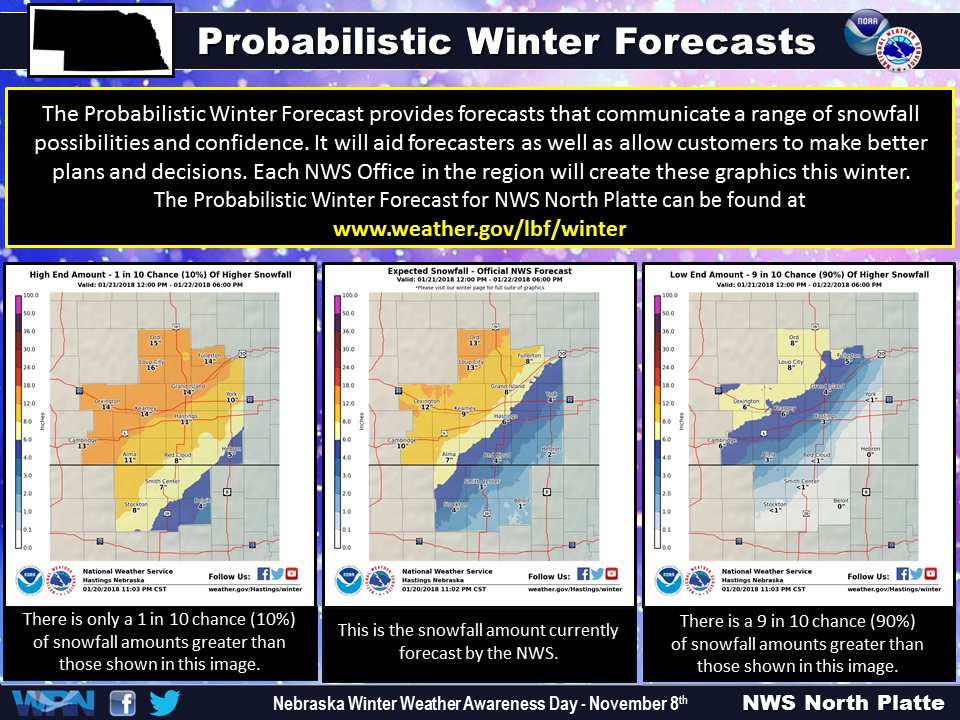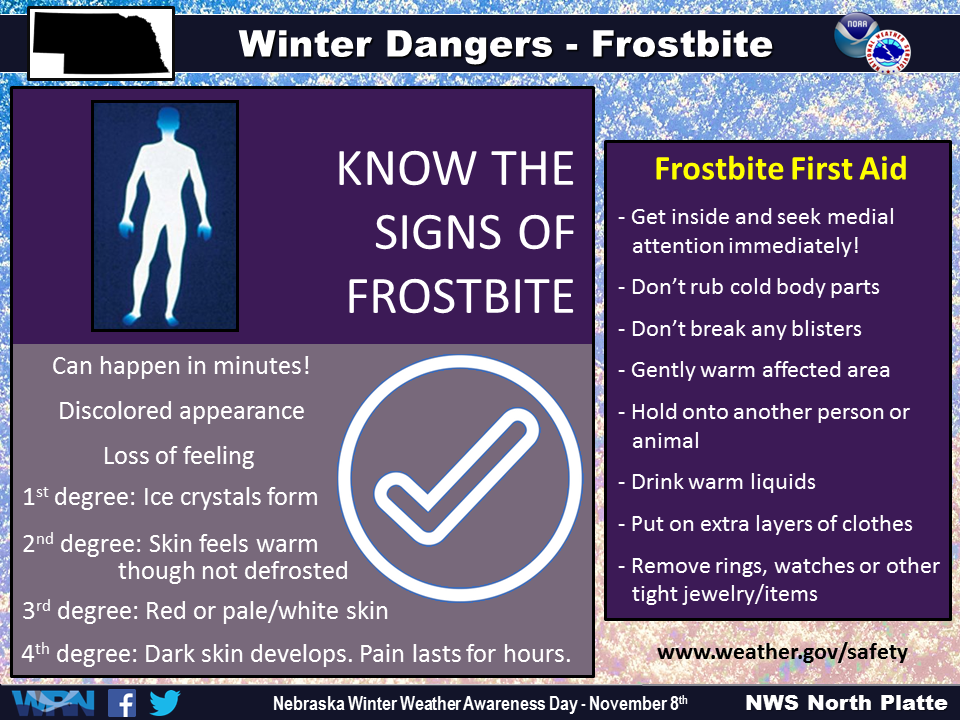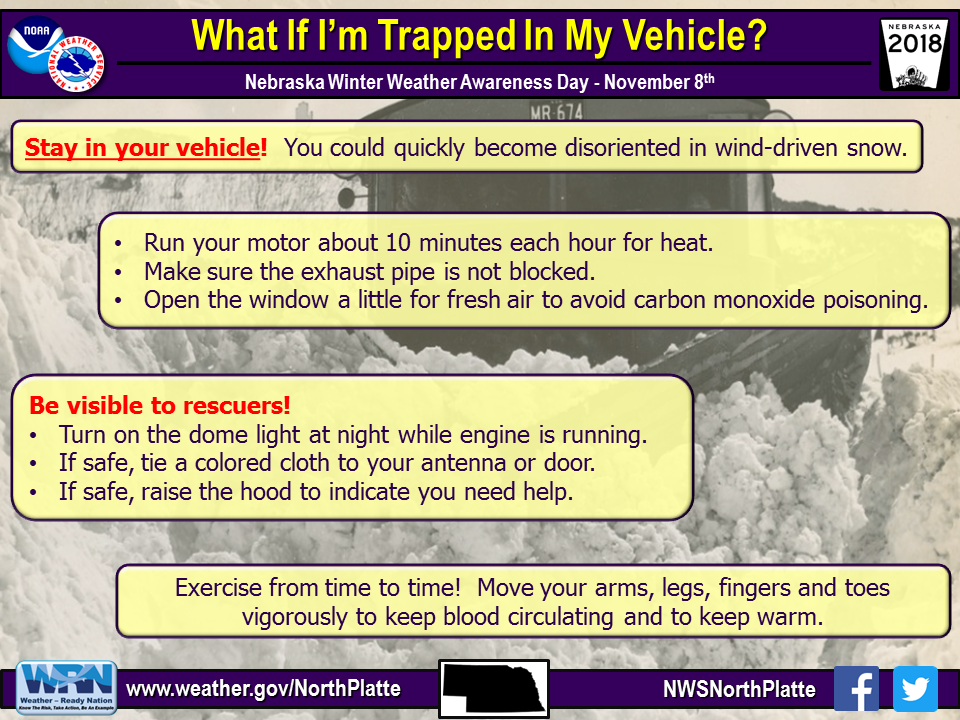
A Pacific storm will move across the Northwest U.S. through Thursday with low elevation rainfall, gusty winds, and mountain snows. A storm crossing the Northeast U.S. will continue gusty to high winds, scattered rain showers and limited snow showers into Thursday. Read More >
North Platte, NE
Weather Forecast Office
Thursday, November 7th is Winter Weather Awareness Day in Nebraska!
2019 Nebraska Winter Weather Awareness Packet
This is an excellent time for everyone: individuals, families, businesses, partners, schools, and media to review their own winter weather preparedness plans. Now is the time to refresh ourselves about the hazards of winter and how to become “Weather-Ready”.
It is especially important for those new to Nebraska to become familiar with our winter weather hazards and our NWS coverage areas, as well as review our list of winter weather safety and travel tips.
Winter Weather Awareness Day Proclamation
NWS North Platte Nebraska Winter Weather Awareness 2019 Press Release
Nebraska Winter Weather Awareness Day
Weather Information Sources
Photo courtesy of Nebraska Department of Roads Region 6
NOAA Weather Radio All-Hazards is the quickest way to get notification of severe weather that may be affecting you. With changing technologies, there are also many other ways to receive weather information. Here are some of the ways you can keep up to date with the latest weather watches and warnings.
NOAA Weather Radio All-Hazards - Popular Features
|
Tone Alarm: Most warnings and many watch messages are broadcast with a tone alarm. The tone will activate all the weather radio receivers which are equipped to receive it, even if the audio is turned off. This is especially useful for warnings which occur during the night when most people are asleep. SAME: Specific Area Message Encoding (SAME) allows a user to specify the particular area for which you wish to receive alerts. This minimizes the number of "false alarms" for events which might not be impacting your area. Selectable Alerting of Events: Some receivers allow a user to turn off the alarm for certain events which might not be important to you. Battery Backup: Since power outages often occur during storms, having a receiver with battery backup can be crucial. External Antenna Jack: While most receivers come with a whip antenna which can usually be extended out from the unit, a user may need an external antenna to get a good reception. Some receivers come with an external antenna jack (normally in the back of the unit) which will allow a user to connect to a larger antenna (indoors or outdoors). Strobe Light: A strobe light accessory provides a visual alert. It's ideal for the hearing-impaired and for use in noisy production environments like metal working facilities to alert personnel of a warning. |
  |
Other Sources
Internet: The National Weather Service's webpage at https://weather.gov allows you a fast and easy look at where the hazards are occurring for the current day. To find out information for your local area, just click on the map in your general area.
Broadcast TV and Radio Stations: Most local radio and television stations across the state automatically receive hazardous watches and warnings and help disseminate that information over the air. They have local knowledge and want to be able to provide their viewers and listeners with the best information they can.
Wireless / Cell Phone technologies: Many cell phone providers are including an option of getting warnings on your cell phone through text messaging or other means. Check with your provider to see if they offer a service like this.
Weather Radio Sites Across The Region
Surrounding States Coverage Maps: Colorado | Kansas | Missouri | Iowa | South Dakota | Wyoming
Additional Information
Anyone who needs information on winter storms in Nebraska should contact their nearest National Weather Service office. Here are the NWS offices that serve Nebraska from east to west:
North Platte:
Omaha/Valley:
Sioux Falls, South Dakota:
Hastings:
Goodland, Kansas:
Cheyenne, Wyoming:

Monday’s statement concerns winter weather forecast terms you may hear.
When a warning is issued during the winter season, will you know what it means and will you know how to respond? During this Nebraska Winter Weather Awareness observance, please become familiar with our list of potentially life-saving winter weather products.
A Winter Storm Watch is an advance forecast notice that hazardous weather such as a blizzard, heavy snow or an ice storm may develop. You should not become unduly alarmed but be aware the threat exists, think about how you would prepare yourself and your family for a winter storm should it develop, monitor forecasts and statements.
A Winter Storm Warning means that hazardous winter weather that poses a direct threat to life or property such as a blizzard, heavy snow, or an ice storm is occurring or expected to occur within the next 12 to 48 hours.
A Blizzard Warning is the forecast of the most hazardous type of winter weather. Visibilities are poor, frequently less than 1/4 mile for three hours or more, due to falling and/or blowing snow and winds are strong with speeds or gusts at or above 35 mph.
An Ice Storm Warning is the forecast of life threatening and damaging accumulations of ice when rain freezes on contact with surfaces. Driving and walking can be extremely hazardous, is discouraged and may be impossible. Power outages may occur for extended periods of time.
Winter Weather Advisories are issued for less serious winter weather conditions that cause significant inconvenience and if caution is not exercised could lead to situations that might threaten life or property. Winter weather advisories may be issued for such events as snow, blowing snow, freezing rain and freezing drizzle.
Monday's Social Media Posts
 |
 |
 |
 |
.png) |
Tuesday’s statement revolves around surviving our harsh winters, whether you are on the road, in the car, or at home.
Winter Storms are considered Deceptive Killers because most deaths are indirectly related to the storm. People die in traffic accidents on icy roads, die of heart attacks shoveling snow and, they die of hypothermia from extreme cold.
If you are caught outside in a Winter Storm try to find shelter and stay dry.
If no shelter is available try to prepare some sort of wind break or snow cave for protection from the wind.
If possible, build a fire. Do not eat snow. It will lower your body temperature and could lead to hypothermia.
If you become stranded in your vehicle during a winter storm, stay with the vehicle and do not try to walk to safety. Disorientation occurs quickly in wind driven snow and cold. Being lost in open country during a blizzard can mean death. Vehicles offer shelter and are the best location to be found by rescue people.
Run the motor about 10 minutes each hour for heat. Open a window slightly for fresh air to avoid carbon monoxide poisoning and make sure the exhaust pipe is not blocked.
Make your vehicle visible to rescuers. Tie a colored, preferably red, cloth to the antenna. Turn on the dome light at night when running the engine. Keep watch for rescue crews. Do not let all occupants sleep at once.
Exercise from time to time by vigorously moving your arms, legs, fingers and toes to stimulate circulation and warm extremities.
If at home or in a building stay inside. Close off unneeded rooms and cover windows at night.
Eat and drink plenty of liquids. Food provides the energy for producing body heat and fluids will prevent dehydration.
Wear layers of loose fitting, light weight, warm clothing.
Tuesday's Social Media Posts
 |
 |
 |
 |
 |
Wednesday’s statement centers on extreme cold, also provided are tips on avoiding frostbite and hypothermia.
Wind Chill is the serious and potentially fatal cooling effect of combined wind and cold on the human body. The National Weather Service issues Wind Chill Warnings for wind chill values of 30 below or lower and Wind Chill Advisories for wind chill values of 20 to 30 below.
For example...if the outside temperature is zero and the wind speed is 25 miles per hour ...then the wind chill is 24 below. If skin is exposed to these conditions, frostbite will occur in about 30 minutes. But if we decrease the air temperature to 10 degrees below zero ...then the wind chill becomes 37 below. The onset of frostbite to exposed skin then decreases to 10 minutes.
Frostbite is damage to body tissue caused by that tissue being frozen. Frostbite causes a loss of feeling and a white appearance of the skin. Seek medical help immediately. If medical help is not available, slowly warm the affected areas.
Avoid overexertion. The stress to the heart from cold temperatures and hard labor from such things as shoveling heavy snow, pushing a car or walking in deep snow, could cause a heart attack.
Hypothermia is the lowering of the body temperature due to exposure to the cold. Symptoms are uncontrollable shivering, memory loss, disorientation, slurred speech, and apparent exhaustion. If the body temperature has fallen below 95 degrees, seek medical help immediately. If medical help is not available, begin warming the person slowly. Warm the body core first. Make sure the person is dry and wrap them in a warm blanket covering the neck and head. Do not give the person alcohol, drugs, or coffee, or any hot beverage or food. Warm broth is better. Do not warm the arms and legs first. This drives the cold blood toward the heart and could cause death.
Wednesday's Social Media Posts
 |
 |
 |
 |
 |
Thursday’s statement concerns winter preparedness and what to do if you are trapped inside, outside, or in your vehicle.
During the winter in the home, you should have available extra food, water, medicine, baby items and first aid supplies. High energy food that requires no cooking or refrigeration is best.
Have a battery powered or hand crank radio, flashlights, lanterns and extra batteries.
Make sure there is an adequate supply of heating fuel and have an emergency heating source such as a fireplace, wood stove or space heater. Have fire extinguishers and smoke detectors and keep them in working order. Fire departments may have trouble responding during and after a winter storm.
Your vehicles should also be prepared for winter storm conditions. Fully winterize and check your vehicle including the battery, heating system and belts. Keep the gas tank as full as possible.
Have a winter storm survival kit in vehicles, including blankets, shovel, high calorie non perishable food, flashlight with extra batteries, first aid kit, knife, towels, sand, tow rope, windshield brush and scraper and booster cables. Have a means of two way communication such as a cell phone. Be sure to have your cell phone charged and consider having an extra external battery.
Check the latest forecasts and road conditions before you start your travel. Use good judgement in determining whether to start or continue your trip. Avoid travel if at all possible during severe winter weather. ...REMEMBER... No trip is a "must" trip. No family gathering, job or appointment is worth your life.
Thursday's Social Media Posts
 |
 |
 |
Measuring Snow

HAZARDS
Active Alerts
National Radar
National Hurricane Center
Storm Prediction Center
Weather Prediction Center
River Flooding
Decision Support
Submit a Storm Report
Recent Storm Reports
CURRENT CONDITIONS
CoCoRaHS
Enhanced Data Display
Local Radar
National Radar Mosiac
Observations
National Snow Cover
Precipitation Mapped
Regional Links
Satellite
Snowfall Analysis
FORECASTS
Area Forecast Discussion
Aviation Weather Center
Local Aviation Weather
Fire Weather
Recreation Forecast
National Graphical Forecast
Local Graphical Forecast
CLIMATE
Local Climate
National Climate
North Platte - Daily
North Platte - Monthly
Valentine - Daily
Valentine - Monthly
Broken Bow - Daily
Broken Bow - Monthly
Imperial - Daily
Imperial - Monthly
NIDIS Drought
NOAA Climate Science
Local Storm Reports
Local Drought Statement
US Dept of Commerce
National Oceanic and Atmospheric Administration
National Weather Service
North Platte, NE
5250 E. Lee Bird Drive
North Platte, NE 69101-2473
308-532-4936
Comments? Questions? Please Contact Us.

